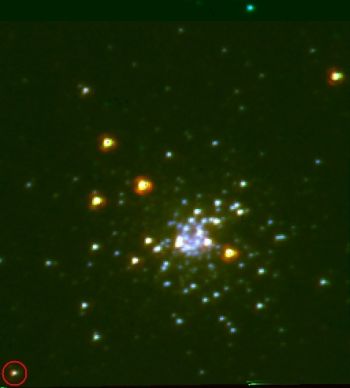AKARI Results
Stars in the later stages of their life cycle as seen by AKARI
- Detection of mass-loss from relatively young red-giant stars in the globular cluster NGC 104 -
AKARI detected evidence of high mass-loss rate from the relatively young red-giant stars based on observations from 3 to 24 micrometres. This finding provides us with new insight into to the evolution of the stars in the later stages of their life.
NGC104, also known as 47 Tuc, is a globular cluster visible from the southern hemisphere in the constellation of Tucana. Globular clusters are dense spherical groups of about one million stars. The distance to NGC 104 is estimated to be around 15000 light years. This particular globular cluster is thought to have formed about 11 billion years ago around the formation of our Galaxy itself. All the massive stars in the cluster have all since perished eons ago, and stars that currently light the cluster are those with masses similar to our own Sun. In truth, it would be more true to say that the stars that populate the cluster are similar to what our Sun will evolve into around 6 billion years from now. Our Sun is currently around 5 billion years old and is steadily burning Hydrogen fuel via nuclear fusion. However, the stars like our Sun in the globular cluster have already extinguished their stock of hydrogen in their cores, the staple fuel of the stars, and have proceeded to the later stages of stellar evolution to become red-giant stars. Theories of stellar evolution predict that the Sun, when it enters this red-giant phase, will eject about 40 per cent of its mass into interstellar space and will eventually become a white dwarf - a small searing white hot ember - the fate of all stars the size of our Sun. This phenomenon is called "mass loss". The fate of a star depends on how this mass loss takes place during the life of the star itself. The mass loss process also contributes to the evolution of interstellar material, as it provides newly processed elements into space. Mass loss is also important for understanding the evolution of the galaxies. Theories predict that such mass loss takes place even in the early stage of the red-giant phase. Many mass-losing stars have been observed at infrared wavelengths but they have all been relatively evolved red-giant stars. To the present day, No example of heavy mass-loss from younger red-giant stars have been found.
AKARI observed NGC 104 with the Near- and Mid-Infrared Camera (IRC) at the wavelengths of 3, 4, 7, 11, 15, and 24 micrometres, and indeed discovered evidence of high-rate mass-loss from younger red-giant stars. Figure 1 shows a three colour composite image of the target from the 3, 11, and 24 micrometre data. The bright red stars seen in the image are mostly in the final stages of the red-giant phase and are losing their material at rates of as high as one millionth of their mass per year. Stars in the earlier red-giant phase are slightly darker than these stars in the image. A marked star located in the bottom-left corner is the star that was discovered to be losing mass at a high-rate while still in the early stage of the red-giant phase. The current result confirms the presence of mass-losing younger red-giant stars for the first time. There are many other stars in a similar (early) evolutionary stage in the cluster but without mass-loss. This result implies that mass loss in the early red-giant phase is not continuous but rather episodic in nature, occurring sporadically over relative short periods in a cosmic sense. Moreover, it was discovered from the data taken at six different infrared wavelengths that the material ejected from the star shows different characteristics from the material ejected from the later stage stars. Further analysis of the data and investigation, together with theoretical modelling will enable us to understand how our own Sun will evolve in the future, and how this evolution will affect the planets in our Solar System.

Figure 1: Three colour composite image of NGC 104 generated from the data at 3, 11, 24 micrometres taken by the Near- and Mid-Infrared Camera (IRC) onboard AKARI. The image covers a 40 light year square region at the distance of the target. The bright red stars seen in the image are in the later stages of the red-giant evolutionary phase and are losing their mass at rates as much as one millionth of their mass per year. The star newly discovered by the AKARI observation is located in the bottom-left corner (see the red circle). The star seems to be in the early stage of the red-giant phase but is undergoing significant mass loss.
This research is mainly carried out by Dr. Y. Ita (ISAS/JAXA) and Dr. N. Matsunaga (Univ. of Tokyo)
Materials
- Figure 1 (© ISAS/JAXA)





